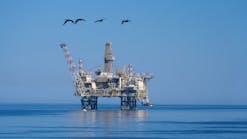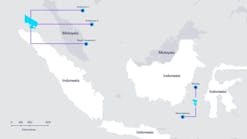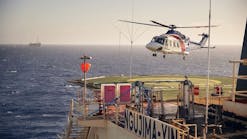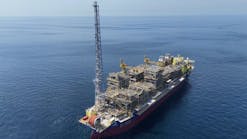- Launching of the Petrojarl Foinaven's new central body, August 1995, in Ferrol. [82,736 bytes]
- Flare stack outfitting. [18,466 bytes]
- The completed Petrojarl Foinaven undergoing final maneuvers before sailaway. [10,617 bytes]
Production from this potential 500MM bbl field will be phased, beginning with a six-year, `early production' system based around an FPSO. Depending on reservoir performance and future exploration results, BP and partners plan then to move to a permanent production system.
The original plan was to fast-track Phase 1, leading to first output just four years after Foinaven's discovery in 1992. A multi-alliance contractor team was appointed for the development. Although Astano was not part of this alliance, it still had a pivotal role as the yard entrusted with the FPSO conversion.
This project marked another step forward in the Ferrol-based yard's progress. It would be Astano's first experience of installing and integrating process plant on an FPSO. BP aimed to cut development time through execution of these tasks in parallel with the rebuilding work. Nevertheless, the timescale for the conversion, two years, looked formidable, given that a whole new mid-body section had to be constructed.
Conversion phases
For the conversion, the management team of McDermott Marine Construction and Golar-Nor Offshore chose a five year-old vessel, the Anadyr, built in Finland for the Russian Navy. BP's view was that a conversion, rather than a newbuilding, would reduce the Foinaven project schedule by almost nine months.Astano signed its contract in August 1994. Key features of the work in Ferrol would include removal of the vessel's bow and stern for upgrading and subsequent joining to the new mid-section of double-skinned hull, thereby extending the vessel's overall length 25 meters to 240 meters. On completion, the unit would be part vessel, part crude and gas processing plant and part storage facility - renamed Petrojarl Foinaven.
Work was divided into phases. Firstly, after the Anadyr was drydocked, its forward body was cut off for modifications. The remainder of the ship, meanwhile, was refloated, turned around and drydocked once more. Then the mid-body was removed for scrapping.
Following completion of the new, longer mid-body, this plus the existing aft body section were floated, turned and joined to the newly modified forward body. Work on this forward section had included raising of the forecastle deck and the addition of a helideck and a new accommodation facility to house 70 crew members.
At the other end, the aft section, Astano had installed a flare stack and an entire crude offloading system. An azimuthing thruster was fitted to both ends of the FPSO.
As well as extending the vessel's length, the new mid-section also broadened the beam by 4 meters to 34m. Here too Astano installed gantry cranes and the turret, along with all mooring and associated production system connections. Aft of the turret, below deck, are situated the cargo tanks, which provide crude storage capacity of 300,000bbl. Separation and compression modules are located on the deck.
Petrojarl Foinaven is equipped with two oil and gas separation trains, each with capacity close to 47,500b/d. Water injection capacity is 165,000b/d. Foinaven gas is compressed at 3,200psi before being reinjected into the nearby An Teallach structure (discovered after the main Foinaven Field).
Process plant was designed by McDermott in the UK and was packaged in pre-assembled units. Astano was responsible for placing and interconnection of these PAUs on the FPSO's new mid-section.
The 3.4 x 106 cu m/d flare and the 5,000 cu m/d crude offloading facility are installed on the poop deck, with power and propulsion plant housed below this deck. Eight 6.5MW, dual-fuel Wartsila 32 diesel engines provide a total output of 52MW.
Petrojarl Foinaven's turret houses connections for 15 risers and 10 mooring lines, operated by Ulstein winches, which also supplied the turret bearing system. The vessel will be able to maintain station in the most severe weather conditions, weathervaning around the turret by means of the thrusters. Shuttle tankers will visit every three days for offloading during peak production periods.
Another key feature of the FPSO is its integrated electrical, instrumentation, control, fire and gas and emergency shutdown system, designed by Astano. Petrojarl Foinaven's system, which includes more than 11,000 signals, is claimed to be one of the most sophisticated yet devised for an FPSO.
Foinaven's two drilling centers are located 3.5km north and west of the FPSO, coordinating a likely total of 14 producer wells, seven water injectors and two gas injectors. Four production flowlines and one gas injection/lift flowline will run from each drilling center to the riser base.
Petrojarl Foinaven will be moored in 500 meters of water, 190km west of Shetland. The FPSO and its associated subsea equipment are designed for a service life of up to 25 years.
Copyright 1997 Oil & Gas Journal. All Rights Reserved.




